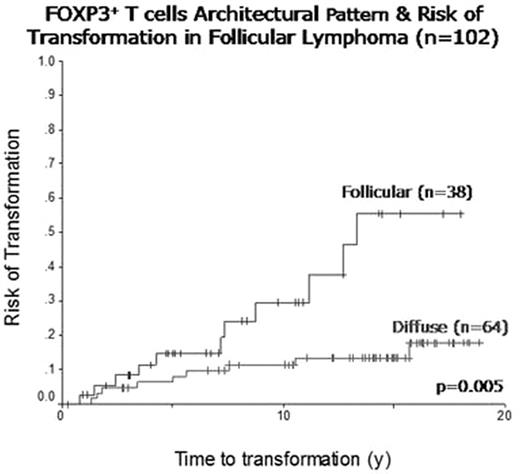Abstract
Background: FL is an indolent heterogeneous lymphoid neoplasm with a variable clinical course. Transformation into an aggressive lymphoma (Tly) is a dominant clinical event frequently associated with inferior survival. No consistent biological markers have been identified that predict for Tly. Recent studies have highlighted the role of the microenvironment, including lymphoma-associated-macrophages (LAM) and Treg cells as important prognostic factors in FL. The nuclear expression of FOXP3 is considered a specific marker of regulatory T cells (Treg). However, most series have included pts variably treated with a wide spectrum of protocols. Using tissue microarrays (TMA) we recently demonstrated that both LAM content and follicular/perifollicular pattern of FOXP3+ T cells are independent adverse prognostic factors for both overall (OS) and progression-free (PFS) survival in advanced-stage FL patients treated uniformly with an aggressive regimen. However, the impact of either LAM or Tregs on Tly is largely unknown. Using the same cohort we assessed the role of these cell types for predicting Tly.
Methods: Between 1987 and 1993, 126 pts were enrolled on a phase II study of BP-VACOP chemotherapy with involved region radiotherapy. All patients were treatment naïve, < 61y and had advanced-stage FL. Paraffin blocks were available in 105 patients. The TMAs consisted of duplicate 1.0mm cores of diagnostic biopsies and were immunostained with both CD68 and a FOXP3-specific antibody. Both CD68+ macrophage content and FOXP3+ T cell content and immuno-architectural patterns were determined and correlated with RT including univariate and multivariate analyses.
Results: There were 102 evaluable cases. The median follow-up of the living pts was 14.3 years and the estimated 10-year OS and Tly rates were 63% and 18%, respectively. The IPI was predictive of OS (RR = 2.4, 95% CI =1.4–4.2, p = 0.002) but not Tly (RR = 2.2, 95% CI =.9–5.1, p = 0.07). Histologic grade included 76 grade 1, 20 grade 2 and 6 grade 3a FLs. Cases revealed 1 to 28 CD68+ cells per high power field (median 7 cells/hpf) and zero to 731 FOXP3+ cells per core (median of 242 cells/core). In 38 pts there was a predominantly intrafollicular or perifollicular localization of positive cells (“follicular Treg pattern”) and in 64 pts the pattern was diffuse. Neither LAM content nor number of FOXP3+ cells had any impact on Tly. However, the immuno-architectural pattern of FOXP3+ cells was predictive of Tly, with the “follicular” pattern showing increased risk of Tly in univariate analysis (p=0.005). A Cox multivariate model including IPI and LAM showed only the FOXP3+ Treg pattern as an independent predictor of Tly (RR = 3.9, 95% CI =.1.5–9.9, p = 0.004).
Conclusions: Treg cell distribution within the tumor is an important predictor of Tly in advanced-stage FL patients treated uniformly with an aggressive treatment regimen. Our results reinforce the importance of a FOXP3 follicular pattern as a good surrogate for functionally active Treg cells within the tumor microenvironment and further highlight the important role of the tumor microenvironment in FL biology.
FOXP3+ T cells Architectural pattern & Risk of Transformation in Follicular Lymphoma (n=102)
FOXP3+ T cells Architectural pattern & Risk of Transformation in Follicular Lymphoma (n=102)
Disclosure: Consultancy: Roche Canada, Genentech, Lilly. Research Funding: Roche Canada, BiogenIdec. Honoraria Information: Roche, Lilly, Johnson & Johnson.


This feature is available to Subscribers Only
Sign In or Create an Account Close Modal